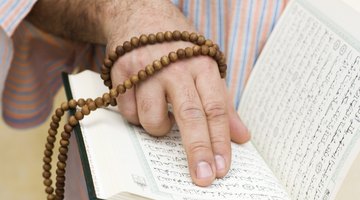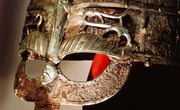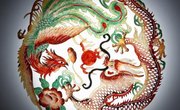The use of prayer beads spans the globe. The earliest examples, according to the University of Missouri Museum of Anthropology, date from the eighth century B.C. in India, and the word “bead” itself comes from a Middle English word for prayer. Most such rosary beads serve the same basic function: to help worshipers count prayers or other ritual recitations. Islam and Catholicism are among the faiths that employ prayer beads. The Catholic beads, known as rosaries, have a more formal sacred function than the more generally assistive role of muslim prayer beads.
How to Use Rosary Beads
The word “rosary” comes from the Latin term meaning "rose garden." The name is metaphorical, denoting a "garden of prayer," according to the University of Missouri Museum of Anthropology. The rose, as a symbol of perfection, is associated with the Virgin Mary, and the rosary's beads count prayers in her honor. A rosary has 59 beads, six of them larger than the others. They are grouped into "decades," five sections of 10 small beads and one larger one. The remaining three beads, two small and one large, form a pendant from which hangs a cross or crucifix.
Saying a Rosary Prayer
The term "rosary" also can refer to the prayers recited with the aid of the beads. Among Christians, the practice began with medieval monks; Pope Leo X bestowed the Church’s formal approval of rosary prayers in 1520. The prayers, like the beads, constitute five sections, each corresponding with a "decade" grouping of beads.
Each sequence of prayers begins with the Lord's Prayer, also called the "Our Father." The 10 prayers of each decade are the "Hail Mary." Depending on the time of year and day of the week, worshipers meditate on a different sequence of "Mysteries" while praying each sequence of beads. During Advent, for instance, the United States Conference of Catholic Bishops recommends worshipers recite the "Five Joyful Mysteries," from Annunciation through Jesus’ "Finding in the Temple." Additional prayers said at specific times during recitation of the rosary are the "Apostles' Creed," the "Glory Be," and the "Hail, Holy Queen."
Islamic Rosary Necklace
Muslims in India call prayer beads "subha," which means "to exalt" in the Urdu language. The Arabic term is "tasbih." Both words often are translated into English as "rosary," although the "rose garden" metaphor is less exact than the connotation of praise or exaltation.
A string of prayer beads includes either 33 or 99 beads, with a single, elongated marker bead at the end. If the string includes 99 beads, marker beads separate them into sets of 33. Like Catholic rosaries, Islamic prayer beads can use any material, but jeweler Oppi Untracht relates one tradition, that of the mystical mendicants known as fakirs, in which the prayer "beads" are really snake vertebrae. Such bead strings show that a fakir knows a charm that cures snakebite.
Using Muslim Rosary for Prayer
The chief difference between Catholic rosary prayers and their Islamic counterparts is that the Muslim prayers are much less formal and are less a feature of religious institutions. Their use is more individual and is often associated with pilgrimage sites. The number 99 is significant, because the muslim prayer beads help Muslims to count and recite, using their right hand to thumb each bead for each of the 99 attributes of God. On reaching the final, elongated bead, the worshiper says the name of God, Allah.
Related Articles
Resources
Writer Bio
Jennifer Spirko has been writing professionally for more than 20 years, starting at "The Knoxville Journal." She has written for "MetroPulse," "Maryville-Alcoa Daily Times" and "Some" monthly. She has taught writing at North Carolina State University and the University of Tennessee. Spirko holds a Master of Arts from the Shakespeare Institute, Stratford-on-Avon, England.











